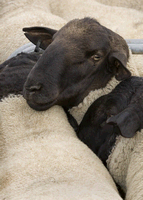Dialogue needed to aid sheep industry woes

Sheep producers are being urged to contact past breeding stock and store lamb suppliers in a bid to agree terms for the sale and possible feeding of stock to minimise the impact on tupping programmes and secure next season’s lamb crops.
That’s the plain advise from advisors, auctioneers and breed societies whom this week are coming to terms with the impact of movement restrictions imposed at the start of the busiest six weeks of the sheep calendar.
ADAS consultant Owen Davies says producers need to act on two fronts; grassland management and securing stock sales or purchases. “Although many lowland farms are carrying good swards the situation for many upland farms is bleak.
“Although time is running out some improved grassland could benefit from a small application of fertiliser – say 30 units/acre – to prolong growth. If that’s already started to decline and there is adequate stocks of even mediocre forage consider housing cattle early and allowing more area for sheep as an interim measure,” he suggests.
Those who took off whole crop cereals could, in some areas, drill fast-growing grass mixes to get a late bite, he adds. “Conditions vary widely but consider all options,” he adds.
 Allowing lamb condition to wane will cost more in the long run, warns MLC’s Duncan Pullar. “Keep pushing lambs even at the expense of ewe condition. Older ewes are more tolerant of changes in body condition than lambs.
Allowing lamb condition to wane will cost more in the long run, warns MLC’s Duncan Pullar. “Keep pushing lambs even at the expense of ewe condition. Older ewes are more tolerant of changes in body condition than lambs.
Some producers had already acted. Northumberland-based Charlie Armstrong has agreed the purchase of ewe lambs for breeding. “My concern is Defra may only allow hauliers to do single farm loads rather than multiple pick-ups. At £1000 a time to bring stock from Wales up to northern England it means it’ll pay to agree a larger purchase off one supplier.
“We may also have to look at agreeing terms for feeding of stock to maintain body condition if movement restrictions aren’t eased.”
Mr Davies says producers could also agree to pay for breeding ewes to be vaccinated on vendor’s farms so they’re ready to go to the tup on arrival. “Some vaccines have to be given three weeks ahead of tupping so it’s time in hand,” he argues.
Tups will also need more care if replacements are not accessible, say advisors. “Teeth, toes and testicles will need attention,” says Mr Pullar. “There’s some evidence dominant tups in good condition can cover 60-70 ewes. Longer term be prepared for the possibility of a prolonged lambing season next year.”
SAC sheep specialist John Vipond said where tups were being expected to cover more ewes than normal flocks should be restricted to smaller grazing areas and moved often. “This will mean ewes find tups more easily and increase the chances of good conception rates.”
Many producers want a timetable from Defra detailing when a return of farm-to-farm movements may be permitted. That took almost three weeks to become an eventuality after the first cases of foot-and-mouth in August but advisors believe it may take longer this time. “The only thing producers can do is be prepared and wait,” encourages Mr Owen.
However, some producers are already calling on government to make financial aid available. Producer Graham Dixon of Alwinton, Northumberland, believes the situation for northern hill farmers is so severe that compensation – or at least an advance SFP payment – should be available. “Ministers fail to see the welfare problem looming.
“It is less than a fortnight away for those producers with no grazing to spare. Some producers have already turned some lambs back on to the hills and if the weather turns these sheep will suffer. It’s a dire situation,” he warned.
